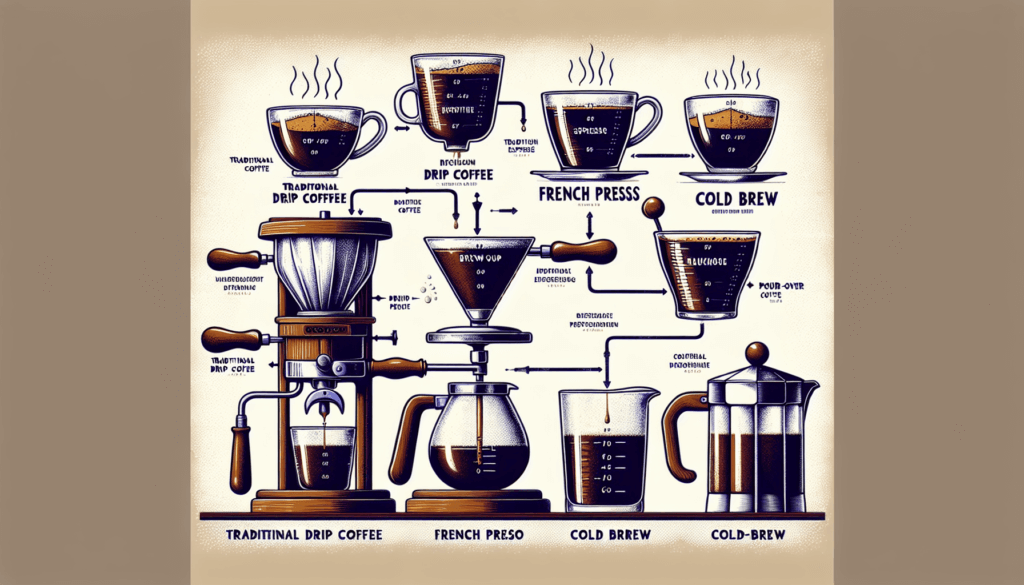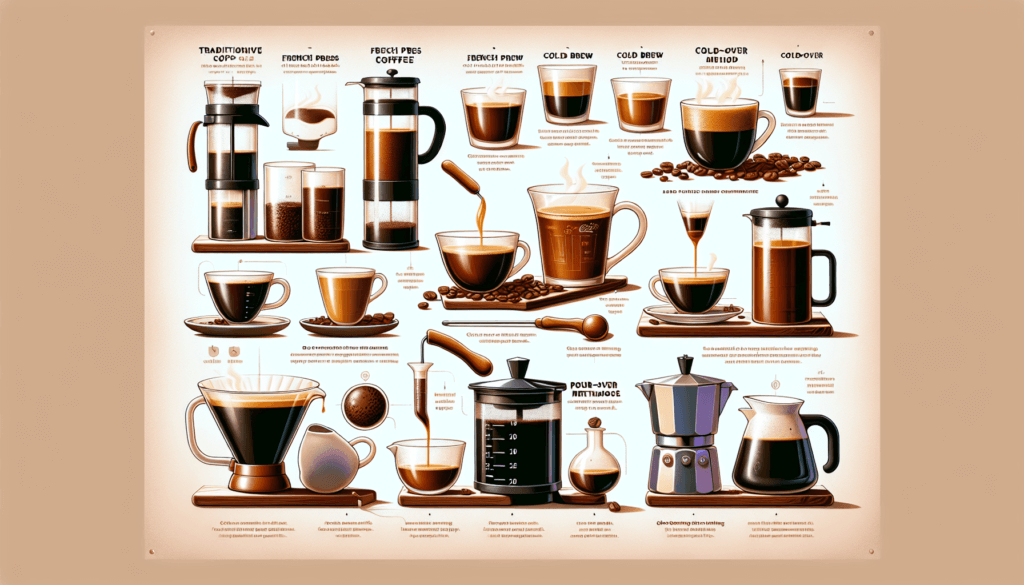Whether you prefer a classic cup of black coffee, a rich and indulgent latte, or a refreshing iced coffee on a hot summer day, the debate on which version of coffee is best has been ongoing. With so many variations to choose from, each offering its own unique taste and experience, it’s no wonder that coffee lovers around the world have differing opinions. In this article, we explore the various versions of coffee and help you navigate through the options to find your perfect cup of joe. So grab a mug, sit back, and let’s embark on a caffeinated journey together.

1. Types of Coffee Beans
1.1 Arabica
Arabica coffee beans are widely regarded as the superior type of coffee beans in terms of taste and quality. These beans are known for their delicate flavors and aromatic characteristics. Arabica beans are grown at higher altitudes, which results in a slower maturation process and a more complex flavor profile. They tend to have a smoother, sweeter taste with notes of fruit, chocolate, and caramel. Arabica beans are also lower in caffeine compared to Robusta beans.
1.2 Robusta
Robusta coffee beans are known for their high caffeine content and strong flavor. These beans are generally considered to be of a lower quality compared to Arabica beans, but they do have their own unique characteristics. Robusta beans are more resistant to pests and diseases, making them easier and cheaper to cultivate. They have a more bitter and earthy taste, with hints of nuts and dark chocolate. Robusta beans are often used in espresso blends to add body and a stronger kick of caffeine.
1.3 Liberica
Liberica coffee beans are the rarest and least commonly found type of coffee beans. They have a distinct aroma and flavor profile, with hints of floral and fruity notes. Liberica beans are known for their large size and irregular shape. They have a unique taste that is often described as smoky or woody. Liberica beans are mainly produced in the Philippines and are gaining popularity among specialty coffee enthusiasts.
2. Roasting Levels
2.1 Light Roast
Light roast coffee beans are roasted for a shorter period of time, resulting in a light brown color and a milder flavor profile. These beans retain more of their natural acidity and brightness, allowing the unique characteristics of the coffee bean to shine through. Light roast coffees often have floral and fruity notes, with a crisp and clean finish. They are less intense and have a higher caffeine content compared to darker roasts.
2.2 Medium Roast
Medium roast coffee beans are roasted for a slightly longer time than light roasts, resulting in a medium brown color and a more balanced flavor profile. The flavors of the coffee bean are enhanced, providing a well-rounded taste. Medium roast coffees have a richer and fuller body with a slight decrease in acidity compared to light roasts. They offer a good balance between the origin flavors of the bean and the roasting process.
2.3 Dark Roast
Dark roast coffee beans are roasted for a longer period of time, resulting in a dark brown color and a bold flavor profile. The beans develop a smoky and caramelized taste with a heavy body. Dark roast coffees have a lower acidity and exhibit flavors such as chocolate, roasted nuts, and even hints of bitterness. The longer roasting process also reduces the caffeine content of the beans. These beans are commonly used for espressos and provide a strong and robust flavor.

3. Brewing Methods
3.1 Drip Coffee
Drip coffee is one of the most popular brewing methods for making a large batch of coffee. It involves pouring hot water over ground coffee beans placed in a filter. The water drips through the coffee grounds, extracting their flavors and oils, and collects in a pot or carafe. Drip coffee tends to result in a clean and smooth cup of coffee with medium body and balanced flavors.
3.2 French Press
The French press brewing method is ideal for those who prefer a stronger and more full-bodied coffee. Coarsely ground coffee is steeped in hot water for a few minutes, and then a plunger with a metal filter is pressed down, separating the coffee grounds from the brewed coffee. This method allows for more oils and flavors to be extracted from the coffee, resulting in a rich and robust cup.
3.3 Espresso
Espresso is a concentrated form of coffee that is brewed by forcing hot water through finely ground coffee beans under high pressure. The result is a small shot of thick and intense coffee, typically served in small cups. Espresso is the base for many coffee drinks such as cappuccinos, lattes, and Americanos. It has a strong and bold flavor with a layer of crema on top, which is a creamy foam.
4. Coffee Additives
4.1 Milk and Cream
Adding milk or cream to your coffee can help mellow out the strong flavors and provide a smoother and creamier taste. It can also add a touch of sweetness and balance the acidity of the coffee. There are various options to choose from, such as whole milk, skim milk, half-and-half, and non-dairy alternatives like almond milk or coconut milk. Experimenting with different types of milk or cream can enhance your coffee experience.
4.2 Sugar and Sweeteners
If you prefer a sweeter cup of coffee, adding sugar or sweeteners can do the trick. Regular granulated sugar, brown sugar, or natural sweeteners like honey or maple syrup can be used to sweeten your coffee to taste. It is important to find the right balance to avoid overpowering the natural flavors of the coffee.
4.3 Flavored Syrups
For those who enjoy a flavored coffee experience, flavored syrups can be a great addition. These syrups come in a variety of flavors, such as vanilla, caramel, hazelnut, and more. They can be added to your coffee to impart a specific flavor profile and provide a unique twist to your beverage. Flavored syrups are commonly used in specialty coffee shops and are easy to use to personalize your coffee at home.

5. Caffeine Content
5.1 High Caffeine Coffees
If you are looking for that extra energy boost, high caffeine coffees are the way to go. Robusta coffee beans have almost double the caffeine content compared to Arabica beans, making them a popular choice for those seeking a strong and stimulating cup of coffee. Dark roast coffees also tend to have slightly lower caffeine content compared to light and medium roast coffees, as the longer roasting process breaks down caffeine molecules.
5.2 Decaffeinated Coffees
For individuals who are sensitive to caffeine or prefer to limit their intake, decaffeinated coffees are a suitable option. Decaffeinated coffee undergoes a process to remove most of the caffeine content while retaining the flavor. There are different methods of decaffeination, including the Swiss Water Process, the Direct Solvent Process, and the Carbon Dioxide Process. Decaffeinated coffee still offers the taste and aroma of regular coffee, but with significantly reduced caffeine levels.
5.3 Moderate Caffeine Coffees
Arabica coffee beans, especially when roasted to a light or medium level, contain a moderate amount of caffeine. These coffees provide a balanced and enjoyable caffeine kick without being overly stimulating. If you prefer to enjoy multiple cups throughout the day or if you prefer a more subtle effect from caffeine, moderate caffeine coffees are a great choice.
6. Health Benefits
6.1 Antioxidants
Coffee is known to be a rich source of antioxidants, which help protect our bodies against damage caused by harmful molecules called free radicals. Antioxidants can help reduce the risk of chronic diseases and contribute to overall health and well-being. Some studies suggest that coffee is one of the most significant dietary sources of antioxidants in Western diets.
6.2 Improved Cognitive Function
The caffeine in coffee has been shown to improve cognitive function and enhance mental alertness. It can help increase attention, focus, and reaction time. Coffee has also been associated with a reduced risk of developing neurodegenerative diseases such as Alzheimer’s and Parkinson’s.
6.3 Lower Risk of Certain Diseases
Regular consumption of coffee has been linked to a lower risk of developing certain diseases. Research has shown that coffee may help reduce the risk of type 2 diabetes, liver disease, certain types of cancer, and cardiovascular diseases. However, it is important to note that individual responses to coffee can vary, and moderation is key to reaping the potential health benefits.

7. Taste Profiles
7.1 Bold and Strong
For coffee lovers who enjoy a bold and strong flavor profile, dark roast coffees and Robusta beans are a great choice. These coffees often have a rich and intense taste, with notes of chocolate, caramel, and roasted nuts. They can provide a robust and satisfying experience for those who prefer a more pronounced flavor in their cup of coffee.
7.2 Smooth and Balanced
Medium roast coffees and certain Arabica beans are known for their smooth and balanced flavor profiles. These coffees offer a more mellow and well-rounded taste, with a good balance of acidity and sweetness. They often have notes of fruit, berries, or even floral hints, providing a pleasing and enjoyable cup of coffee.
7.3 Light and Fruity
Light roast coffees and certain specialty Arabica beans are prized for their light and fruity flavor profiles. These coffees tend to have a higher acidity and vibrant flavors, with notes of citrus, berries, or even tropical fruits. They offer a refreshing and lively sensory experience, perfect for those who appreciate a lighter and more delicate coffee taste.
8. Environmental Considerations
8.1 Organic Coffee
Organic coffee is grown without the use of synthetic pesticides, herbicides, or fertilizers. It is produced using environmentally friendly farming practices that prioritize sustainability and biodiversity. By choosing organic coffee, you can support eco-friendly agriculture and contribute to the preservation of natural ecosystems.
8.2 Fair Trade Coffee
Fair trade coffee ensures that coffee farmers receive fair prices for their crops and have access to better living and working conditions. Fair trade certification also promotes environmental sustainability and community development. By purchasing fair trade coffee, you are supporting ethical trade practices and making a positive impact on the lives of coffee farmers.
8.3 Shade-Grown Coffee
Shade-grown coffee is cultivated under the canopy of trees, preserving the natural habitat and promoting biodiversity. This traditional farming method helps maintain the health of the ecosystem, provides habitat for birds, and reduces the need for chemical inputs. Choosing shade-grown coffee can have a positive impact on the environment and contribute to the conservation of wildlife.

9. Cost Effectiveness
9.1 Brewing at Home
Brewing your coffee at home can be a cost-effective option in the long run. By investing in high-quality coffee beans and equipment such as a coffee grinder and brewing machine, you can enjoy your favorite cup of coffee at a fraction of the cost of buying from cafés. Additionally, brewing at home allows you to control the strength and flavor of your coffee to suit your personal preference.
9.2 Buying from Cafés
While buying coffee from cafés may be more expensive compared to brewing at home, it can offer a convenient and social experience. Cafés often provide a wide range of coffee options, including specialty and seasonal blends. Visiting a café allows you to enjoy the expertise of baristas and explore new flavors and brewing methods that you may not have access to at home.
9.3 Instant Coffee
Instant coffee is a convenient and affordable option for coffee lovers on the go. It is made by freeze-drying or spray-drying brewed coffee, resulting in a powdered form that can be easily dissolved in hot water. Instant coffee offers a quick and simple way to enjoy a cup of coffee without the need for brewing equipment. However, the flavor and quality may not match that of freshly brewed coffee.
10. Personal Preference
10.1 Aromatic and Flavorful
If you value the aroma and flavor of coffee above all else, exploring different types of coffee beans and brewing methods can help you discover the perfect cup. Experiment with light roast Arabica beans, which often provide more pronounced flavors and nuanced aromas. Opt for brewing methods such as French press or pour-over, which allow for a more immersive coffee experience and highlight the unique characteristics of the beans.
10.2 Energy Boost
For those seeking an energy boost, dark roast coffees and high caffeine options can deliver the desired effect. The higher caffeine content in these coffee varieties can provide a quick pick-me-up and enhance mental alertness. Consider choosing Robusta beans or dark roast Arabica beans, especially if you prefer a stronger and bolder cup of coffee.
10.3 Morning Ritual
For many, coffee is an integral part of their morning routine and serves as a comforting ritual to start the day. Choose a brewing method and coffee bean combination that aligns with your personal taste preferences and helps create a sense of familiarity and enjoyment during your morning coffee ritual. Whether it’s a drip coffee with a smooth and balanced flavor or an espresso with a rich and intense taste, make your morning cup of coffee a moment to savor.
In conclusion, the best version of coffee depends on individual preferences and desired characteristics. Whether you appreciate the delicate flavors of Arabica beans, the strong kick of Robusta beans, or the unique taste of Liberica beans, there is a coffee type for everyone. Experiment with different roasting levels, brewing methods, and coffee additives to personalize your coffee experience. Consider the environmental and ethical aspects of your coffee choices, and remember to enjoy your cup of coffee with your own personal touch.


